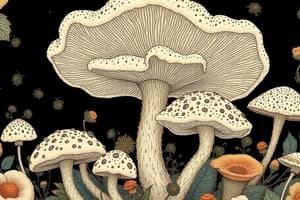Podcast
Questions and Answers
Which division of fungi produces non-motile spores?
Which division of fungi produces non-motile spores?
- Amastigomycota (correct)
- Chytridiomycota
- Deuteromycota
- Zygomycota
Which division is known for reproducing asexually by motile zoospores?
Which division is known for reproducing asexually by motile zoospores?
- Ascomycota
- Chytridiomycota (correct)
- Zygomycota
- Basidiomycota
What type of reproduction is associated with Basidiomycota?
What type of reproduction is associated with Basidiomycota?
- Sexual reproduction through basidiospores (correct)
- Asexual reproduction through motile zoospores
- Sexual reproduction is unknown
- Asexual reproduction through spore
Which division is known for having a sexual reproduction mechanism that is unknown?
Which division is known for having a sexual reproduction mechanism that is unknown?
Which of the following fungi is an example of Ascomycota?
Which of the following fungi is an example of Ascomycota?
Which of the following statements is true about Chytridiomycota?
Which of the following statements is true about Chytridiomycota?
What role do saprophytes play in the ecosystem?
What role do saprophytes play in the ecosystem?
What is the primary benefit mycorrhizae provide to their host plants?
What is the primary benefit mycorrhizae provide to their host plants?
How can parasitic fungi negatively impact trees?
How can parasitic fungi negatively impact trees?
Which sign is NOT a common indication of parasitic fungi in trees?
Which sign is NOT a common indication of parasitic fungi in trees?
Which characteristic is used to identify poisonous fungi?
Which characteristic is used to identify poisonous fungi?
What describes edible mushrooms in terms of gill color?
What describes edible mushrooms in terms of gill color?
Which condition suggests the presence of root rot caused by fungi?
Which condition suggests the presence of root rot caused by fungi?
What should never be done when unsure about mushroom edibility?
What should never be done when unsure about mushroom edibility?
What are the primary components of fungi cell walls?
What are the primary components of fungi cell walls?
How do fungi obtain energy and grow?
How do fungi obtain energy and grow?
Which of the following best describes fungi?
Which of the following best describes fungi?
What is the aggregate structure of hyphae called in fungi?
What is the aggregate structure of hyphae called in fungi?
What is the estimated range of identified fungal species?
What is the estimated range of identified fungal species?
What type of growth do fungi exhibit?
What type of growth do fungi exhibit?
Study Notes
Fungi Overview
- Fungi diverged from a common ancestor approximately 1.5 billion years ago and fully colonized land around 500 million years ago.
- They are distinct life forms, neither plants nor animals, yet share characteristics of both groups.
- Fungi have cell walls composed of chitin and/or cellulose.
Biological Characteristics
- Fungi are eukaryotic organisms with true nuclei and organelles.
- Require water and oxygen; do not include obligate anaerobes.
- Thrive in diverse habitats as long as organic matter is available.
- Approximately 70,000 to 100,000 species have been identified.
Fungal Structure
- Exhibit indeterminate clonal growth; can be unicellular (yeasts) or multicellular (hyphae).
- Mycelium is an aggregate of hyphae, while sclerotium is a hardened mass of mycelium.
- Fruiting bodies, such as mushrooms, are composed of hyphae.
Ecological Roles
- Acts as saprophytes, decomposing dead tissue and organic matter.
- Forms symbiotic relationships as symbionts, notably through mycorrhizae with plants to enhance nutrient uptake.
- Can be parasites, feeding on living tissue in animals and humans.
Mycorrhizal Relationships
- Mycorrhizae grow inside/outside plant roots to increase water and nutrient absorption.
- In return, plants provide mycorrhizae with carbohydrates.
- Fungal competition can affect tree health by competing for nutrients and potentially causing decay.
Interaction with Trees
- Fungal mycelium can obstruct tree vascular tissues (xylem and phloem), impacting nutrient and water transport.
- Fungi may release toxic compounds and enzymes that damage tree tissues.
- Armillaria (honey fungus) is known to cause root rot, leading to decreased stability.
Identifying Parasitic Fungi
- Look for fruiting bodies such as mushrooms and bracket fungi.
- Check tree bark for discoloration, dark spots, or unusual patterns.
- Examine tree bases for fungal mycelia around roots and signs of decay in the wood.
Recognizing Poisonous and Edible Fungi
- Poisonous fungi may have irregular caps, discolored gills, and foul odours.
- Edible mushrooms often have smooth caps, brown or tan gills, and lack stem rings.
- Always confirm identification before consumption.
Fungi Divisions
- Amastigomycota: Non-motile spores; chitin cell walls.
- Chytridiomycota: Asexual reproduction through motile zoospores; single posterior flagellum.
- Zygomycota: Elongated multiple haploid nuclei; asexual reproduction via spores.
- Ascomycota: Sexual reproduction by forming sacs; includes morels and yeast.
- Basidiomycota: Sexual reproduction through basidiospores; includes mushrooms and puffballs.
- Deuteromycota: Sexual reproduction remains unknown.
Fungal Diversity
- Non-motile spores and chitin cell walls are common characteristics.
- Decomposers of organic materials; significant examples include bread mould and various fungi affecting amphibian populations.
Studying That Suits You
Use AI to generate personalized quizzes and flashcards to suit your learning preferences.
Related Documents
Description
Explore the fascinating world of fungi with this quiz. Learn about their unique characteristics, evolutionary history, and their ecological importance. Discover how fungi differ from plants and animals while playing crucial roles in various ecosystems.




